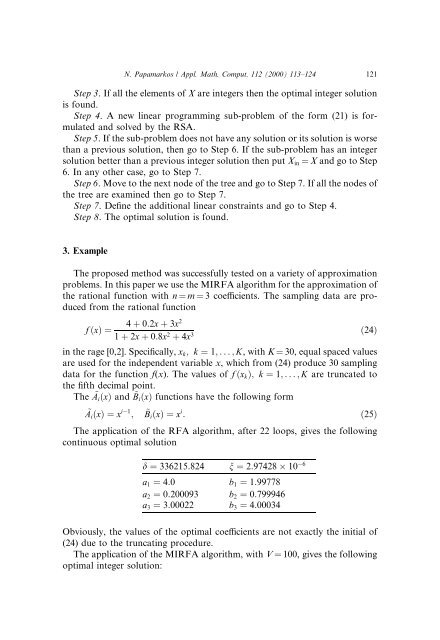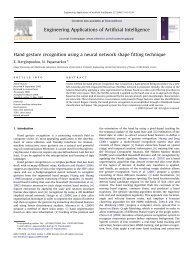On the approximation of real rational functions via mixed-integer ...
On the approximation of real rational functions via mixed-integer ...
On the approximation of real rational functions via mixed-integer ...
Create successful ePaper yourself
Turn your PDF publications into a flip-book with our unique Google optimized e-Paper software.
N. Papamarkos / Appl. Math. Comput. 112 (2000) 113±124 121Step 3. If all <strong>the</strong> elements <strong>of</strong> X are <strong>integer</strong>s <strong>the</strong>n <strong>the</strong> optimal <strong>integer</strong> solutionis found.Step 4. A new linear programming sub-problem <strong>of</strong> <strong>the</strong> form (21) is formulatedand solved by <strong>the</strong> RSA.Step 5. If <strong>the</strong> sub-problem does not have any solution or its solution is worsethan a previous solution, <strong>the</strong>n go to Step 6. If <strong>the</strong> sub-problem has an <strong>integer</strong>solution better than a previous <strong>integer</strong> solution <strong>the</strong>n put X in ˆ X and go to Step6. In any o<strong>the</strong>r case, go to Step 7.Step 6. Move to <strong>the</strong> next node <strong>of</strong> <strong>the</strong> tree and go to Step 7. If all <strong>the</strong> nodes <strong>of</strong><strong>the</strong> tree are examined <strong>the</strong>n go to Step 7.Step 7. De®ne <strong>the</strong> additional linear constraints and go to Step 4.Step 8. The optimal solution is found.3. ExampleThe proposed method was successfully tested on a variety <strong>of</strong> <strong>approximation</strong>problems. In this paper we use <strong>the</strong> MIRFA algorithm for <strong>the</strong> <strong>approximation</strong> <strong>of</strong><strong>the</strong> <strong>rational</strong> function with n ˆ m ˆ 3 coecients. The sampling data are producedfrom <strong>the</strong> <strong>rational</strong> function4 ‡ 0:2x ‡ 3x 2f …x† ˆ…24†1 ‡ 2x ‡ 0:8x 2 ‡ 4x 3in <strong>the</strong> rage [0,2]. Speci®cally, x k ; k ˆ 1; ...; K, with K ˆ 30, equal spaced valuesare used for <strong>the</strong> independent variable x, which from (24) produce 30 samplingdata for <strong>the</strong> function f(x). The values <strong>of</strong> f …x k †; k ˆ 1; ...; K are truncated to<strong>the</strong> ®fth decimal point.The A ~ i …x† and ~B i …x† <strong>functions</strong> have <strong>the</strong> following form~A i …x† ˆx i1 ; ~B i …x† ˆx i : …25†The application <strong>of</strong> <strong>the</strong> RFA algorithm, after 22 loops, gives <strong>the</strong> followingcontinuous optimal solutiond ˆ 336215:824n ˆ 2:97428 10 6a 1 ˆ 4:0 b 1 ˆ 1:99778a 2 ˆ 0:200093 b 2 ˆ 0:799946a 3 ˆ 3:00022 b 3 ˆ 4:00034Obviously, <strong>the</strong> values <strong>of</strong> <strong>the</strong> optimal coecients are not exactly <strong>the</strong> initial <strong>of</strong>(24) due to <strong>the</strong> truncating procedure.The application <strong>of</strong> <strong>the</strong> MIRFA algorithm, with V ˆ 100, gives <strong>the</strong> followingoptimal <strong>integer</strong> solution:




